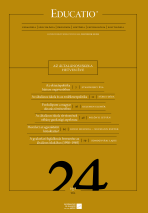A PISA-program mint médiajelenség
PISA as a Media Phenomenon
Author(s): Zsuzsanna HorváthSubject(s): Education, Media studies, Communication studies
Published by: Akadémiai Kiadó
Keywords: mediatization; PISA reception; publicity;
Summary/Abstract: International pupils’ knowledge assessment from the seventies until the present time has been communicated in Hungary in different ways: mostly in the form of written texts offering proposals for development contributions that have been inspired by critical comparisons issuing from well-known experts. In the years after the new millenium began, public education processes have been prompted by the joined influence of more than one factor – and one of these is the PISA program, whose results (which are published every three years) have given the development period 2014–2020 a new element: PISA results were seen as result indicators emanating from European development sources. At the same time, a growing “internationalisation” has contributed to transforming one’s way of speaking about this phenomenon: in our opinion, both the PISA program and how it is communicated can be described using information society concepts, broadening the field for PISA reception, and giving room to different, often contradictory beliefs (from deep engagement to sharp criticism). This essay endeavours to outline and interpret the main issue: PISA in the media-rich world, while offering some examples from the reception given to the 2009 survey (reading comprehension) and mathematics as applied knowledge (2012). In addition, we try here to find explanations for the extremely contradictory assessments of and views about the PISA program.
Journal: Educatio
- Issue Year: 24/2015
- Issue No: 2
- Page Range: 80-88
- Page Count: 9
- Language: Hungarian

